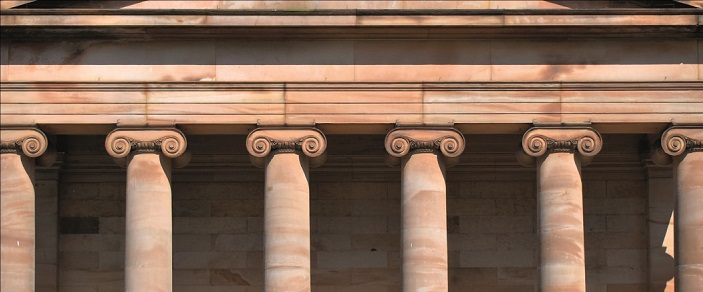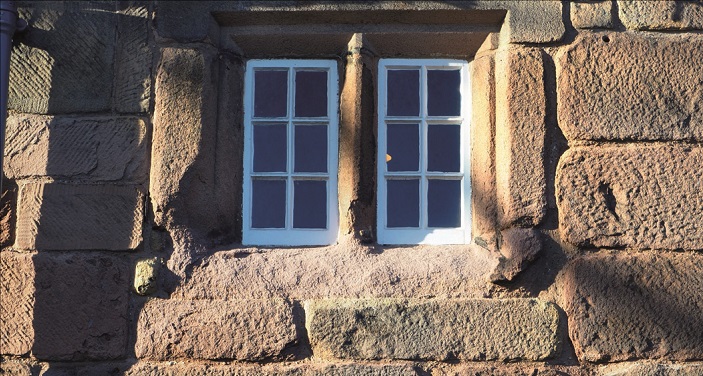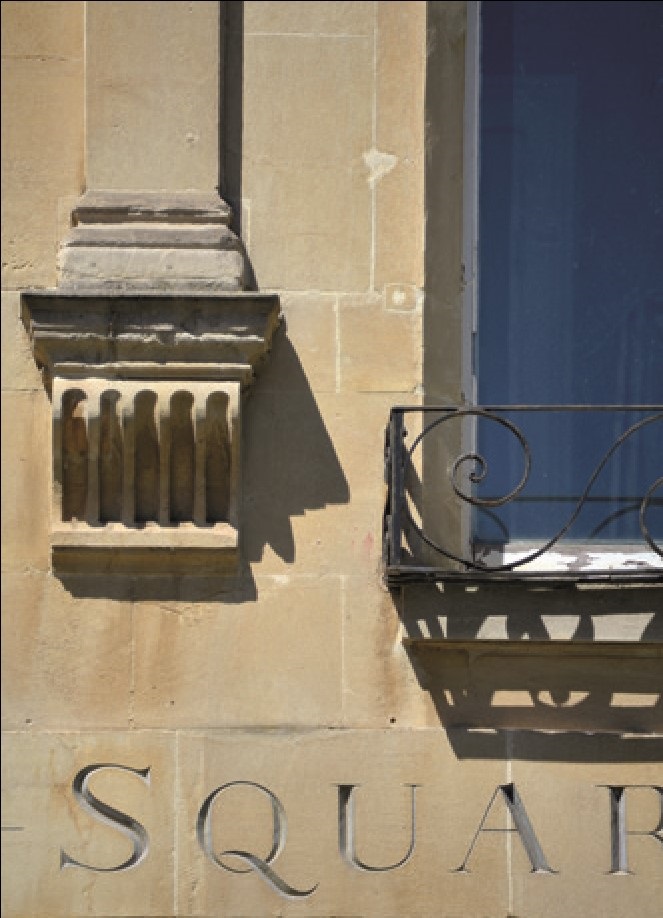Sandstones and Limestones
Jonathan Taylor
 |
| Edinburgh’s classical 18th century architecture is built of a fine grained Carboniferous sandstone which takes carving well and is extremely durable |
Before the development of mass transportation systems – first the canals and then the railways – buildings were predominantly constructed with local materials. Stone was always the favoured walling material, and local building stones still dominate the character of towns and villages across the UK, alongside brick and timber framing in areas where stone was not available.
Limestones and sandstones are the most commonly used building stones in the UK, largely because they are found across a wider area of the country than others, with limestones predominating in the south and sandstones in the north. These sedimentary rocks were formed from mineral sediments that accumulated on what was once the floor of a warm, shallow sea. The sediment was either the eroded remains of pre-existing rocks – including igneous, sedimentary and metamorphic rocks – or fragments of calcium carbonate mostly from shells or the skeletons of marine organisms. When compacted over millions of years, cementation took place by the migration of some minerals to form rock. Calcium carbonate in the form of calcite is the predominant cement in limestones but it is also found in many sandstones. Other cementitious minerals include magnesian carbonates, ferrous compounds and, particularly in sandstones, silica.
When used as building stone, the properties of sedimentary rocks is influenced by the nature of the particles, the strength and composition of the cementation and by the bedding planes which form as a result of the layering of sediment on the sea floor.
Sedimentary rocks with deep layers and no obvious bedding planes produce a building stone known as a freestone which can, in theory, be worked and used in any plane. However, most sedimentary rocks should be placed the same way up as they were originally laid, with the bedding planes parallel to the ground. Conservators regularly find examples in historic buildings where whole sections of sandstones and limestones have sheared off because the bedding plane was placed vertically or at a steep angle. Columns and stone posts such as window mullions are particularly prone to this type of defect.
STONE ROOFING SLATES AND FLAGS
Some sandstones and limestones have particularly pronounced bedding planes, often as a result of the inclusion of thin layers of micaceous clay minerals in the sedimentation process. These layers make the stone fissile, enabling it to be split into flagstones or stone roofing slates, but making it less suitable as a walling material.
 |
| A relatively durable sandstone from the millstone grit series in Wirksworth, Derbyshire: in this case the building had been neglected in the past, exposing the masonry to saturation and frost damage. |
Limestone roofing slates are characteristic of towns and villages in the Cotswolds and in the east Midlands around the village of Collyweston, for example. Sandstone roofing slates are common in much of the north of England and parts of Scotland, as well as further south in South Wales and Herefordshire and in the South East where Horsham stone was used.
These stone slates tend to be chunkier and less regular than roofing slates of true slate, which is a metamorphic rock formed under heat and pressure from sedimentary deposits containing fine particles of clay. In the process the clay minerals align themselves with the direction of pressure, resulting in relatively impervious material that is extremely fissile, so it can be split into much finer and far lighter slates. In the late 19th century following the rapid growth of the railway network, local vernacular materials started to be replaced by better materials, and in areas with good rail connections many vernacular roofing traditions have now almost completely disappeared. Many of the quarries closed and generations of roofers have grown up knowing only how to use metamorphic slates. As a result, new roofs which were made using the local materials were detailed using the skills taught nationally, not in the local vernacular. Original roof which are detailed in the local vernacular are rare and very precious, providing a model for conservators to follow.
BUILDING STONES AND THEIR PERFORMANCE
The properties of sandstones and limestones vary widely depending on the cohesiveness of the cementation, the hardness of the minerals they bind, and the pore structure of the resulting matrix. Although some are made impermeable by the presence of particular minerals, most sandstones and limestones are highly porous with an interconnected pore structure. This makes them highly permeable, and when used as a building stone bedded in a lime mortar in a traditional solid wall construction, the structure is said to ‘breathe’. Any wind-driven rain falling on the outside will make the surface damp, but it dries quickly too. Between rain showers even in the winter, the damp never penetrates far into the masonry. If properly maintained, most of the wall remains dry, insulating the interior from both the temperatures outside and from the evaporation taking place at the exterior surface. The large mass of masonry also helps to moderate humidity and temperature, helping to keep the interior cool in the summer months.
Lime mortars tend to draw moisture out of the masonry, and a well pointed wall will encourage rainwater to run down the face and not into the joints. In areas where stone was readily available, cheaper houses would have been built with random rubble stonework and rendered with lime mortar to produce an even finish (smooth or rough cast) and to protect it from the elements. These renders – known as harling in Scotland – have been widely removed by owners who wish to show off their natural stone walls. The alteration reduces their resilience to weathering, and often exposes stones that are naturally friable and easily eroded by wind and rain.
COMPOSITION
 |
| Fine carving in Bath’s oolitic limestone |
The particles of a sandstones are mainly composed of quartz grains, but they may also include various other rock fragments and other minerals such as feldspar. Small stones, fossils, shell fragments and, in the more fissile stones, micaceous clay minerals may also be included. Many sandstones are extremely granular and easily distinguished from limestones, while others, such as Edinburgh’s Craigleith are much finer.
Cementation by silica is strongest in older rocks which have been subjected to most heat and pressure. These are extremely hard and durable, but also more difficult to shape. Prior to the development of stone cutting machinery, the hardest stones were generally avoided unless there really wasn’t any alternative, and even then they were only used for the most important buildings such as churches. Conversely, softer and more friable stones were often used for ordinary building work and protected by broad eaves, careful detailing of drips and other features designed to minimise the flow of water down the masonry.
In limestone the particles may include fragments of fossils and shells, as well as a smaller proportion of grains of quartz and other minerals common in sandstones. Often the body of limestone is extremely fine grained, enabling it to be easily carved, but fossil inclusions may be far harder, causing chips in the carving that may need to be filled in later.
Most limestones used as building stones are extremely durable, but they are particularly vulnerable to pollution, resulting in a blackened sulphate skin that can delaminate. The softest limestone found in historic buildings is chalk, which was used where there was no viable alternative, and always carefully protected from the elements.
Conservation of masonry structures depends largely on good maintenance and attention to detail where repairs are required. Local traditions such as renders or projecting courses of stone which shed water, will have evolved to cope with any deficiencies in the local stone, or to enable the walls to be built using less material. Identifying these details often requires careful detective work because of the changes in construction technology and practice that have occurred since the early 19th century.
While all conservation relies on changing as little as possible, defects in masonry are often inherent, and alterations may be required to replace defective stones, to add weatherings or to remove rusting metal cramps for example. Correct identification of the cause of deterioration can be complicated, and may require the services of specialist building surveyors and geologists as well as stonemasons.



